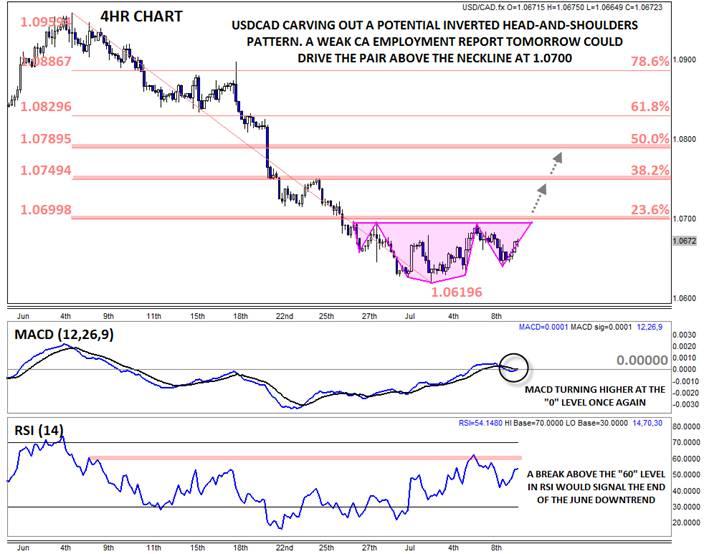![]()
At the start of this week, we asked if USDCAD could be the “Mecca†of G10 volatility this week. While that prediction has not come to fruition (the pair has been contained to just a 70-pip range thus far this week), the fundamental and technical picture is starting to look more constructive ahead of tomorrow’s Canadian employment report.
Tackling the fundamental side of the ledger first, data out of the Great White North has been mixed over the past few days. The biggest headline was Monday’s terrible Ivey PMI report, which came out at just 46.9 vs. 51.3 expected. This report marked the second straight month of outright contraction according to the indicator, suggesting that the Canadian economy took a stumble in Q2 after a strong start to the year. That said, Canadian housing data has taken a bit of the sting out of the poor PMI report, with Building Permits rising at 13.8% rate m/m and Housing Starts also beating expectations.
In the US, yesterday’s Fed minutes were generally hawkish, with the FOMC stating that it would likely end QE with a $15B taper in October, but the greenback is broadly unchanged since the release. Bullish traders are hoping today’s better-than-expected initial jobless claims report (304k vs. 316k anticipated) will provide a positive catalyst for the buck. Without a clear economic trend in favor of either of the North American nations, the USDCAD has simply consolidated below 1.07. Looking forward, traders are hoping that tomorrow’s Canadian employment report (26k jobs, 7.0% unemployment expected) can wake the pair from its stupor.
Technical View: USDCAD
Monday’s article covered the longer-term perspective for the USDCAD, but over the past two weeks, rates have carved out a potential inverted Head-and-Shoulders formation. This classic price action pattern shows a gradual shift from a downtrend (lower lows and lower highs) to an uptrend (higher highs and higher lows) and typically marks a significant bottom on a chart. Readers should take note though, this pattern will not be confirmed unless we see a break above the neckline at 1.0700; until then, the USDCAD is just in a consolidation range.
Looking to the secondary indicators reinforces the potential for bullish shift in the coming days. The MACD has been trending up for over two weeks now and is turning higher above the “0†level as of writing. The RSI indicator, meanwhile, is essentially neutral around 50, but a break above the 60 area in the coming days would signal an end to the June downtrend and open the door for a more substantial recovery in the USDCAD exchange rate.
At this point, the USDCAD’s outlook hinges on tomorrow’s employment report. If the report disappoints expectations, the pair could break above the 1.07 neckline, clearing the way for a move up to 1.0750 (the 38.2% Fib retracement) or 1.0790 (the 50% Fib retracement) next. On the other hand, a decent employment report could keep the USDCAD locked in its recent 1.0600-1.0700 consolidation zone in the near-term.
This research is for informational purposes and should not be construed as personal advice. Trading any financial market involves risk. Trading on leverage involves risk of losses greater than deposits.
Recommended Content
Editors’ Picks
EUR/USD clings to gains above 1.0750 after US data

EUR/USD manages to hold in positive territory above 1.0750 despite retreating from the fresh multi-week high it set above 1.0800 earlier in the day. The US Dollar struggles to find demand following the weaker-than-expected NFP data.
GBP/USD declines below 1.2550 following NFP-inspired upsurge

GBP/USD struggles to preserve its bullish momentum and trades below 1.2550 in the American session. Earlier in the day, the disappointing April jobs report from the US triggered a USD selloff and allowed the pair to reach multi-week highs above 1.2600.
Gold struggles to hold above $2,300 despite falling US yields

Gold stays on the back foot below $2,300 in the American session on Friday. The benchmark 10-year US Treasury bond yield stays in negative territory below 4.6% after weak US data but the improving risk mood doesn't allow XAU/USD to gain traction.
Bitcoin Weekly Forecast: Should you buy BTC here? Premium

Bitcoin (BTC) price shows signs of a potential reversal but lacks confirmation, which has divided the investor community into two – those who are buying the dips and those who are expecting a further correction.
Week ahead – BoE and RBA decisions headline a calm week

Bank of England meets on Thursday, unlikely to signal rate cuts. Reserve Bank of Australia could maintain a higher-for-longer stance. Elsewhere, Bank of Japan releases summary of opinions.
